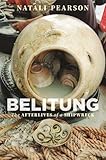Belitung : The Afterlives of a Shipwreck / Natali Pearson.
Material type: TextPublisher: Honolulu : University of Hawaii Press, [2022]Copyright date: ©2023Description: 1 online resource (230 p.) : 11 b&w illustrationsContent type:
TextPublisher: Honolulu : University of Hawaii Press, [2022]Copyright date: ©2023Description: 1 online resource (230 p.) : 11 b&w illustrationsContent type: - 9780824894801
- Cultural property -- Protection -- China
- Cultural property -- Protection -- Indonesia -- Billiton Island
- Excavations (Archaeology) -- Indonesia -- Billiton Island
- Museums -- Acquisitions -- Moral and ethical aspects
- Pottery, Chinese -- Tang-Five dynasties, 618-960
- Shipwrecks -- Indonesia -- Billiton Island
- Treasure troves -- Indonesia -- Billiton Island
- Underwater archaeology -- Indonesia -- Java Sea
- HISTORY / Asia / Southeast Asia
- China
- Indian Ocean
- Indonesia
- Maritime Silk Road
- Singapore
- shipwrecks
- underwater cultural heritage
- 910.4/520959819 23/eng/20220928
- DS647.B6 P43 2023
- online - DeGruyter
| Item type | Current library | Call number | URL | Status | Notes | Barcode | |
|---|---|---|---|---|---|---|---|
 eBook
eBook
|
Biblioteca "Angelicum" Pont. Univ. S.Tommaso d'Aquino Nuvola online | online - DeGruyter (Browse shelf(Opens below)) | Online access | Not for loan (Accesso limitato) | Accesso per gli utenti autorizzati / Access for authorized users | (dgr)9780824894801 |
Frontmatter -- Contents -- Illustrations -- Preface -- Acknowledgments -- Abbreviations -- Introduction -- CHAPTER ONE Created -- CHAPTER TWO Wrecked -- CHAPTER THREE Provenanced -- CHAPTER FOUR Contested -- CHAPTER FIVE Reimagined -- Conclusion -- Appendix: Exhibition list -- Notes -- Bibliography -- Index -- About the Author
restricted access online access with authorization star
http://purl.org/coar/access_right/c_16ec
In 1998, the Belitung, a ninth-century western Indian Ocean–style vessel, was discovered in Indonesian waters. Onboard was a full cargo load, likely intended for the Middle Eastern market, of over 60,000 Chinese Tang-dynasty ceramics, gold, and other precious objects. It is one of the most significant shipwreck discoveries of recent times, revealing the global scale of ancient commercial endeavors and the centrality of the ocean within the Silk Road story. But this shipwreck also has a modern tale to tell, of how nation-states appropriate the remnants of the past for their own purposes, and of the international debates about who owns—and is responsible for—shared heritage. The commercial salvage of objects from the Belitung, and their subsequent sale to Singapore, contravened the principles of the 2001 UNESCO Convention on the Protection of the Underwater Cultural Heritage and prompted international condemnation. The resulting controversy continues to reverberate in academic and curatorial circles. Major museums refused to host international traveling exhibitions of the collection, and some archaeologists announced they would rather see the objects thrown back in the sea than ever go on display. Shipwrecks are anchored in the public imagination, their stories of treasure and tragedy told in museums, cinema, and song. At the same time, they are sites of scholarly inquiry, a means by which maritime archaeologists interrogate the past through its material remains. Every shipwreck is an accidental time capsule, replete with the sunken stories of those on board, of the personal and commercial objects that went down with the vessel, and of an unfinished journey. In this moving and thought-provoking reflection of underwater cultural heritage management, Natali Pearson reveals valuable new information about the Belitung salvage, obtained firsthand from the salvagers, and the intricacies in the many conflicts and relationships that developed. In tracing the Belitung’s lives and afterlives, this book shifts our thinking about shipwrecks beyond popular tropes of romance, pirates, and treasure, and toward an understanding of how the relationships between sites, objects, and people shape the stories we tell of the past in the present.
Mode of access: Internet via World Wide Web.
In English.
Description based on online resource; title from PDF title page (publisher's Web site, viewed 29. Mai 2023)


